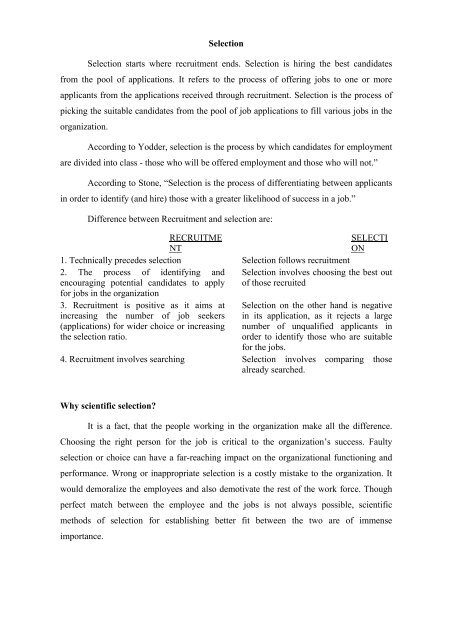UNIT – I Lesson 1 HRM – AN OVERVIEW Lesson Outline Nature of ...
UNIT – I Lesson 1 HRM – AN OVERVIEW Lesson Outline Nature of ...
UNIT – I Lesson 1 HRM – AN OVERVIEW Lesson Outline Nature of ...
Create successful ePaper yourself
Turn your PDF publications into a flip-book with our unique Google optimized e-Paper software.
Selection<br />
Selection starts where recruitment ends. Selection is hiring the best candidates<br />
from the pool <strong>of</strong> applications. It refers to the process <strong>of</strong> <strong>of</strong>fering jobs to one or more<br />
applicants from the applications received through recruitment. Selection is the process <strong>of</strong><br />
picking the suitable candidates from the pool <strong>of</strong> job applications to fill various jobs in the<br />
organization.<br />
According to Yodder, selection is the process by which candidates for employment<br />
are divided into class - those who will be <strong>of</strong>fered employment and those who will not.”<br />
According to Stone, “Selection is the process <strong>of</strong> differentiating between applicants<br />
in order to identify (and hire) those with a greater likelihood <strong>of</strong> success in a job.”<br />
Difference between Recruitment and selection are:<br />
RECRUITME<br />
SELECTI<br />
NT<br />
ON<br />
1. Technically precedes selection Selection follows recruitment<br />
2. The process <strong>of</strong> identifying and Selection involves choosing the best out<br />
encouraging potential candidates to apply<br />
for jobs in the organization<br />
<strong>of</strong> those recruited<br />
3. Recruitment is positive as it aims at Selection on the other hand is negative<br />
increasing the number <strong>of</strong> job seekers in its application, as it rejects a large<br />
(applications) for wider choice or increasing number <strong>of</strong> unqualified applicants in<br />
the selection ratio.<br />
order to identify those who are suitable<br />
for the jobs.<br />
4. Recruitment involves searching Selection involves comparing those<br />
already searched.<br />
Why scientific selection?<br />
It is a fact, that the people working in the organization make all the difference.<br />
Choosing the right person for the job is critical to the organization’s success. Faulty<br />
selection or choice can have a far-reaching impact on the organizational functioning and<br />
performance. Wrong or inappropriate selection is a costly mistake to the organization. It<br />
would demoralize the employees and also demotivate the rest <strong>of</strong> the work force. Though<br />
perfect match between the employee and the jobs is not always possible, scientific<br />
methods <strong>of</strong> selection for establishing better fit between the two are <strong>of</strong> immense<br />
importance.
















